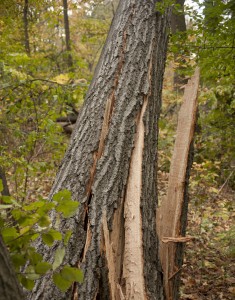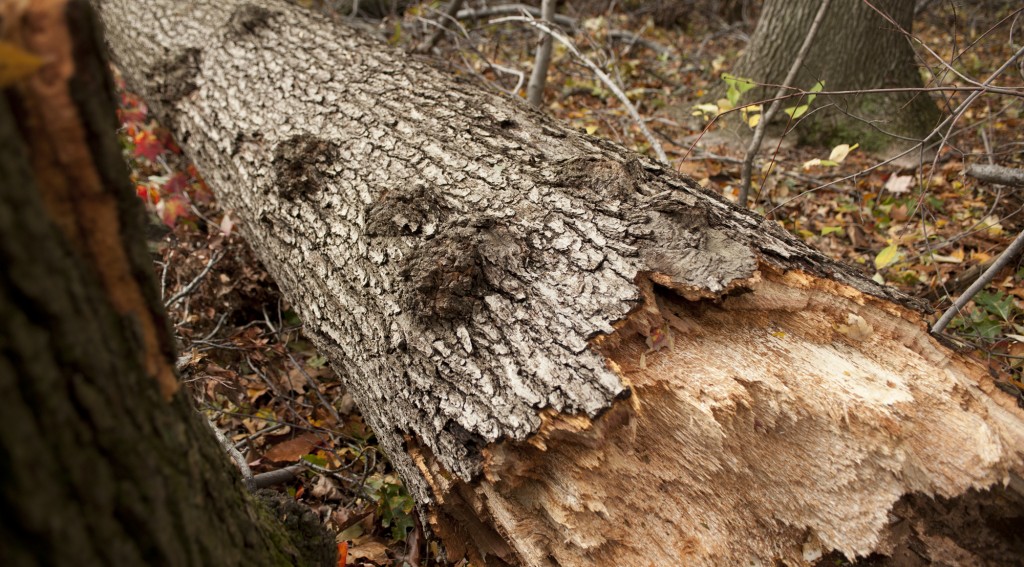Hurricane Sandy: Stimulating Debate About Global Warming
Posted in Science on January 16 2013, by Scott Mori
Scott A. Mori has been studying New World rain forests for The New York Botanical Garden for over 35 years. He has witnessed an unrelenting reduction in the extent of the tropical forests he studies and as a result has become interested in the ecosystem services provided by them.
 Hurricane Sandy left a path of fallen trees throughout its course, including over 100 at The New York Botanical Garden. Included in this devastation at the NYBG was a 101-foot-tall red oak thought to be 200 years old; this majestic tree provided the right habitat for spring-blooming plants in the Azalea Garden. Repeated storms with such force and frequency are making people ask if the storms could be related to global warming.
Hurricane Sandy left a path of fallen trees throughout its course, including over 100 at The New York Botanical Garden. Included in this devastation at the NYBG was a 101-foot-tall red oak thought to be 200 years old; this majestic tree provided the right habitat for spring-blooming plants in the Azalea Garden. Repeated storms with such force and frequency are making people ask if the storms could be related to global warming.
Climatologists have demonstrated that impressive swings in climate have taken place over the course of earth’s history—for example, the northeastern United States has been covered by glaciers during some periods and by tropical forests at other times. Because of these extremes of climate, it is difficult to say with certainty what the cause of such violent weather is. The proximate, or direct, cause of Hurricane Sandy was the convergence of three “normal” weather patterns: 1) a tropical storm with very strong winds coming from the south; 2) a trough of low pressure from the Arctic that strengthened the storm as it moved north; and 3) a block of high pressure in the northeastern Atlantic which forced the storm inland. In contrast, the more difficult question is: “What are the ultimate causes that make storms stronger and more frequent?”
One ultimate cause frequently cited to explain extreme weather is that global warming is responsible, not only for more severe and frequent storms, but also for the extreme droughts recently occurring in some areas and unprecedented floods in other areas. These weather events have such profound impacts on human health and economics that they need to be part of an open, international, scientific debate in order to determine the contribution of mankind to global warming, the subsequent changes of weather caused by it, and what can be done to ameliorate the negative impacts caused by it.
In order to make decisions, scientists employ the scientific method, a process in which a hypothesis is stated, data are collected to test the hypothesis, and the hypothesis is rejected or supported based on the results of the data. If a hypothesis is supported over and over again, it may then be considered a law. Examples of hypotheses that apply to global warming are 1) have greenhouse gases increased in the atmosphere; 2) have the world’s temperatures increased; and 3) do greenhouse gases emitted by humans contribute to global warming?

The most compelling data supporting hypothesis one is the monitoring of carbon dioxide in the atmosphere at Mauna Loa, Hawaii from 1958 to the present. This study has demonstrated a consistent increase in atmospheric carbon dioxide over that period. Data for supporting hypothesis two is based on graphs showing the world’s temperature increasing rapidly since the beginning of the Industrial Revolution.
A major controversy, however, is centered on hypothesis three, because it is not clear if human activity or natural temperature variations are the cause of the increase in global temperature. It is, however, known that greenhouse gases spewed into the atmosphere increase global temperature and that it is more than just carbon dioxide that acts as a greenhouse gas; e.g., if carbon dioxide is ranked one in terms of its heat trapping ability, methane is somewhere on the order of 25 times more efficient, and hydrofluorocarbons, known as super greenhouse gases, are 11,000 times more potent! As a result of man’s activities, water vapor, aerosols, and particulate matter released into the atmosphere in such unprecedented amounts–even if they are not the main cause of global warming–certainly add to the problem.
 Governor Cuomo, telling the New York Times that “climate change is real,” recognizes that this problem needs to be addressed. “It is denial to say each of these situations [occurs] once-in-a-lifetime,” he explains. “There is a 100-year flood every two years now. It is inarguable that the sea is warmer and there is a changing weather pattern, and the time to act is now.” A new book by John Englanders, High Tide on Main Street, provides the data and graphs that support Governor Cuomo’s statement–thus, this book is a must read for getting an overview of sea level rise as it applies to New York City and other coastal cities.
Governor Cuomo, telling the New York Times that “climate change is real,” recognizes that this problem needs to be addressed. “It is denial to say each of these situations [occurs] once-in-a-lifetime,” he explains. “There is a 100-year flood every two years now. It is inarguable that the sea is warmer and there is a changing weather pattern, and the time to act is now.” A new book by John Englanders, High Tide on Main Street, provides the data and graphs that support Governor Cuomo’s statement–thus, this book is a must read for getting an overview of sea level rise as it applies to New York City and other coastal cities.
The late Senator Daniel Patrick Moynihan said, “Everyone is entitled to his own opinion, but not his own facts.” And Rush Holt, a former senator and current congressman from New Jersey, has suggested that political decisions about the environment need to be made based on facts, not opinion. The only good result left by Hurricane Sandy is that it has made clear to politicians the obligation they have to facilitate debates about environmental issues, something that was mostly lacking in the last presidential debates, but so important to our economic and environmental future.


Wow, only a few years ago we had a hurricane hit our shores and it blew down lots of trees. But no one thought it was global warming, they just thought it was a hurricane. What’s wrong with New Yorkers?